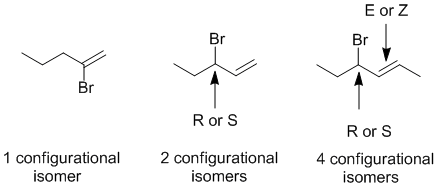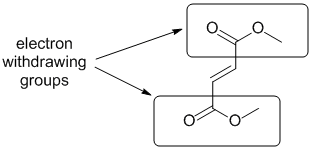
Here is an post-mortem analysis / "how to" for the MT. The questions are split by the sections. At the start of each section are a few suggestions of what to look for or how to tackle the question type.
RELATIVE PROPERTIES:
Identify the controlling feature, which is not
always as obvious as it may appear. Look for two pairs of similar systems to compare
that have minimal differences in structure. If a compound is named, draw it out.
If a reaction is involved, identify the type of reaction and then what the controlling
factors are.
Qu1:
Alkenes and alkynes undergo electrophilic addition with acids which are controlled by carbocation stability and the nature of groups attached to the pi unit. Alkynes are less reactive since they would require the much less favourable termolecular pathway to avoid the formation of the very unfavourable vinyl carbocations. The ease of carbocation formation dictates the rate of reaction. In the case of alkynes, the vinyl C+ would be too unstable and a slower termolecular mechanism occurs, so the alkyne is the slowest. The more highly substituted alkene will give the more highly substituted C+ and hence reacts the fastest.

Qu2:
Use the pKas of the acids: terminal alkyne CH = 25, ammonia NH = 35 or think about the bases that are used to prepare an acetylide ion ! But what about the internal alkyne ? The H is attached to an sp3 C, and they tend to be less acidic.
![]()
Qu3:
Reaction is the Diels-Alder reaction and we are looking at the dienes reacting with the dienophile maleic anhydride (drawn in the question). The reactivity increases in the Diels-Alder reaction with electron donating groups on the diene and the diene needs to be able to adopt an s-cis conformation. The simplest diene, 1,3-butadiene, has conformational flexibility and can readily rotate at room temperature into the reactive s-cis conformation. (2Z,4Z)-hexa-2,4-diene can rotate into the reactive conformation, but the terminal methyl groups would destablise that conformation, making that diene less reactive. 1,3-cyclopentadiene is locked in the reactive s-cis conformation and has electron donating groups attached at each end of the diene system. The molecules are drawn in the s-cis conformation below.

Qu4:
The oxymercuration / demercuration of an alkene adds the HO and H across the C=C in a Markovnikov fashion. Here we are asked about 3,3-dimethylbut-1-ene. The major product is the Markovnikov product, followed by the anti-Markovnikov product but there will be none of the rearranged product since the reaction does not proceed via an carbocation.

Qu5:
Configurational isomers result at chirality centers (R or S) and double bonds (E or Z).

Qu6:
This question relates directly to the sodium borohydride reactivity experiment from the laboratory where the reactivity aldehydes > ketones > esters.

Qu7:
The reaction is a catalytic hydrogenation. The reaction is fastest for the weakest pi bond and that is found in an alkyne so the alkyne is the most reactive. In contrast, the C=C in arenes are less reactive than those in alkenes.

Qu8:
Carbocation
stability.... Look at the C atom bearing the charge and what's attached to it. The simple primary carbocation is the least stable. The other two structures are allylic carbocations and hence are resonance stabilised. But one of them is a secondary carbocation (more stable) and the other is a primary carbocation.
![]()
Qu9:
To count allylic H we need to count the H attached to the C atoms that are adjacent to (but not part of) double bonds.

Qu10:
All the bonds are CC bonds. The factors involved are (1) the hybridisation of the C atoms involved and (2) the bond order. Double bonds are shorter than single bonds. Bonds involving two sp2 C atoms are shorter than two sp3 C atoms (due to higher s character).

STARTING MATERIALS, REAGENTS AND PRODUCTS:
If you are trying to find the product, then
you should probably just work forwards through the sequence of reactions.
If you are looking for the starting material,
then working backwards is probably the best way to go....
Basically depends on the need to know and identify
the reactions, this is often triggered by looking at the functional groups in
the molecules.
Qu11:
Working forwards... Dissolving metal reduction of the alkyne initially gives an alkene. Aqueous acid hydration of the alkene gives the Markovnikov product alcohol after a carbocation rearrangement (a 1,2-hydride shift) to give the more stable tertiary carbocation.

Qu12:
Working backwards...looking at the two oxygen containing groups in the product, step 2 looks to be the acid catalysed ring opening of an epoxide which is consistent with step 1 which is a peracid forming the epoxide from an alkene. Note that the -OH group comes from the epoxide O and is trans to the Nu system (EtOH) which is at the more substituted position.

Qu13:
Working forwards...Step 1 is the basic (strong nucleophile) ring opening of an epoxide using an acetylide ion followed by step 2, hydration of the alkyne giving the Markovnikov product enol (no rearrangement since no carbocation is formed) that tautomerises to give the methyl ketone. Under the reaction conditions (H+ and heat), the alcohol will dehydrate driven by the extra stability of the conjugated enone product.

Qu14:
Working backwards.....step 3 is partial reduction of an alkyne to a cis alkene, step 1 and 2 look like an acetylide has been formed from a terminal alkyne and 3-bromopropene adds a 3 C unit forming the internal alkyne.

Qu15:
Working backwards..... the product is a halohydrin which is make by addition to an alkene, which is formed by elimination. So, radical bromination (NBS/heat) followed by strong base / heat (NaOMe/heat) then HOBr.

Qu16:
Working forwards...Conjugated diene heated with a substituted alkene (the dienophile) indicates a Diels-Alder reaction. This is followed by alkene ozonolysis with a reductive work-up.

Qu17:
Working backwards...The last two reagents and the product indicate using a Grignard reaction with carbon dioxide to give the carboxylic acid. The Grignard is formed using an alkyl halide (remember your laboratory expt). Step 2 would account for the cyclopropane formation from a cyclohexene and therefore step 1 looks like an allylic bromination.

Qu18:
Working forwards... Bromination of the alkene gives a 1,2-dibromide which is then eliminated using strong base / heat to make a diene. Heating with the disubstituted alkyne is a Diels-Alder reaction.

REGIO- and STEREOCHEMISTRY:
How well do you know your reagents ? Look
at what has actually happened in terms of the reaction functional group transformation
and then first look for any regiochemical issues then finally the stereochemistry
last (it's the hardest to sort out). In cases where more than one product
is formed in equal amounts (e.g. the enantiomers), then both must be selected
for full marks, part marks are given when only one of the pair is selected.
Advice : in each case draw the starting material in the
conformation in which is reacts or the product in the conformation in which
it is initially formed using wedge-hash diagrams. It is a good idea to draw
the materials in such a way that the new bonds are in the plane of the page.
Once you have drawn the materials it may also be good for you to use model kits
for these questions too. Once you have drawn the materials in this way,
you may need to consider rotations around sigma bonds to make your answer match
the options. An alternative approach could be to assign configurations
to your drawn answer to compare them with the options - this can be slow and
prone to error.
Qu19:
Radical addition of HBr to the alkyne via the more stable radical (benzylic) is followed by allylic radical bromination. Step 3 is acid catalysed hydration of the alkene which proceeds via the more stable (benzylic) carbocation.

Qu20:
The catalytic hydrogenation is a syn addition, giving the cis-alkene. The cis-alkene is reacted with cold alkaline potassium permanganate to give a 1,2-diols via a syn addition.

Qu21:
Rearrange the alkene to the more stable trisubstituted system via protonation / deprotonation of the alkene results in a carbocation that can rearrange to a more stable tertiary carbocation via a 1,2-methyl shift and leading to a more substituted / more stable alkene. The alkene then reacts with a peracid to give the epoxide from the alkene via a syn addition.

Qu22:
Under these conditions, HBr adds to the alkene to give the Markovnikov product alkyl bromide via the more stable tertiary carbocation. When reacted with a strong, bulky base, we get elimination of the alkyl bromide to give the anti-Zaitsev product, the less highly substituted alkene. This is followed by halohydration via an anti-addition and putting the HO- at the tertiary position.

Qu23:
Addition of HBr to the diene gives an allylic bromide. Hydroboration / oxidation with 9-BBN gives the "anti-Markovnikov" alcohol (B atom at the less hindered).

Qu24:
The alkene reacts with a peracid to give the epoxide from the alkene via a syn addition. NaOMe is a strong nucleophile and opens the epoxide via an SN2 like reaction, attacking at the least hindered end of the epoxide to give a hydroxy methyl ether. When heated with acid, the alcohol dehydrates to give the more stable alkene (Zaitsev product).

Qu25:
The catalytic hydrogenation is a syn addition, giving the cis-alkene. This is followed by bromination via an anti-addition. Remember how to decode Fischer projections vertical bonds away, horizontals towards you. The issue is that because we started with a trans-alkene (i.e. Ph and Me groups anti), we need to be careful. If you draw the diol in the conformation in which it is formed then rotate to create the conformation for the Fischer projection, this will reveal that the -OH groups need to be on opposite sides.

PI SYSTEMS:
All about knowing properties of pi systems such as resonance, structure, bonding, shapes, and terminologies etc.
Qu26:
Conjugation requires an extended pi system (at least 3 atoms) where the pi systems can interact
(parallel orbitals, not perpendicular). The image below has highlighted the p orbitals (blue circles for top down view of vertical p orbitals, and black for those that are perpendicular to the others).

Qu27:
Resonance contributors are derived via the delocalisation of the pi electrons across the pi system and can be derived by pushing curly arrows. Use the rules for recognising resonance structures.

Qu28:
Hydration of alkenes with aq. sulfuric acid is controlled by the rate of carbocation formation where the most stable carbocation forms fastest. Here, the most stable cation that can form is tertiary and allylic.

Qu29:
The key issues are (1) C=C are stronger that C≡C and hence alkenes are more stable, (2) conjugated systems are more stable than isolated systems, and (3) alkyl groups on pi bonds stabilise them, so a more substituted alkene is more stable. Therefore the most stable isomer is the conjugated diene that includes a trisubstituted alkene unit.
![]()
Qu30:

Qu31:
Tautomers (remember alkyne hydration ?) of ketones are the enols.

Qu32:
The reaction is a Diels-Alder reaction and we are looking at the dienophile component. Since the dienophile is the electrophile in a normal Diels-Alder reaction, the most reactive system will have the most electron withdrawing groups.

Qu33:
Organic cis / trans nomenclature is based on the stereochemistry of the parent chain that forms the root of the name (longest chain that includes the principal functional group).

Qu34:
Resonance contributors are derived via the delocalisation of the pi electrons with the pi system and can be derived by pushing curly arrows. Use the rules for recognising resonance structures.
